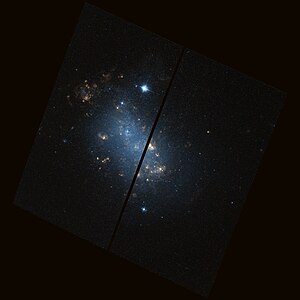NGC 1156
| Galaxy data from NGC 1156 |
|
|---|---|

|
|
| Photo from the Hubble Space Telescope | |
| AladinLite | |
| Constellation | Aries |
|
Position equinox : J2000.0 , epoch : J2000.0 |
|
| Right ascension | 02 h 59 m 42.3 s |
| declination | + 25 ° 14 ′ 16 ″ |
| Appearance | |
| Morphological type | IB (s) m / HII |
| Brightness (visual) | 11.7 mag |
| Brightness (B-band) | 12.3 mag |
| Angular expansion | 2.6 ′ × 1.7 ′ |
| Position angle | 34 ° |
| Surface brightness | 13.2 mag / arcmin² |
| Physical data | |
| Redshift | 0.001251 ± 0.000005 |
| Radial velocity | +375 ± 1 km / s |
|
Stroke distance v rad / H 0 |
(20 ± 1) x 10 6 ly (6.11 ± 0.43) Mpc |
| history | |
| discovery | William Herschel |
| Discovery date | November 13, 1786 |
| Catalog names | |
| NGC 1156 • UGC 2455 • PGC 11329 • CGCG 485-006 • MCG + 04-08-06 • IRAS 02567 + 2502 • 2MASX J02594283 + 2514282 • VV 531 • GC 627 • H II 619 • HIPASS J0259 + 25 • KARA 121 • LDCE 0160 NED015 | |
NGC 1156 is an irregular dwarf galaxy with extensive star formation regions of the Hubble type IBm in the constellation Aries on the ecliptic . It is estimated to be 20 million light years from the Milky Way and about 13,000 light years in diameter.
The object was discovered on November 13, 1786 by the German-British astronomer William Herschel .
The galaxy NGC 1156 imaged by GALEX
Web links
Commons : NGC 1156 - collection of images, videos, and audio files
- SIMBAD Astronomical Database
- astronews.com: Picture of the day July 11, 2019

